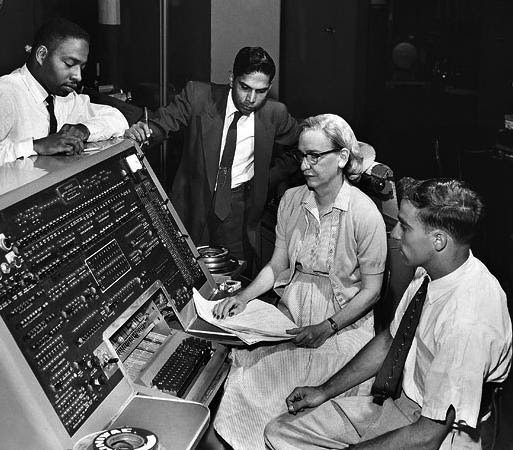So, what’s the story behind COBOL?Â
Let’s review this fascinating chapter in tech history.
Computer Languages Change the Game of Data ProcessingÂ
The history of computing is complex and involves many great minds, ideas, and overlapping innovations. Let’s focus on a few major points that led the world to the modern computer. You may remember the name Alan Turing from history lessons or 2014’s successful film The Imitation Game featuring Benedict Cumberbatch. The film portrays the story of Turing, who devised the Turing machine and its role in cracking code during World War II. The fundamental idea that also carried on was Turing’s development of a machine that could compute anything that is computable. Computers developed after that point expanded and grew from that central concept.Â
As computing advanced, computer languages and software development became more complex. As computers emerged on the scene in the mid-20th century, each computer manufacturer tinkered with and developed their own programming language. It soon became apparent that the use of multiple languages would present a problem as technologies began to merge, coexist, or as companies ended up with different computers under one roof—as it happened to the Department of Defense in the late 1950s.Â
A group of programmers devised a solution: a common language that ran efficiently on computers built by different manufacturers. This new language was called COBOL— Common Business Oriented Language. It proved to be functional and particularly apt for government and business data processing.Â
The Origins of COBOL
As one of the first programming languages, COBOL holds its rightful place in tech history. Along with Fortran (a contemporary), it was also one of the first languages to be based on English words. Thanks to Grace Hopper, one of the earliest computer programmers, the language evolved to be what it is. Hopper honed her skills in the U.S. Naval Reserve, where she wrote machine code during World War II for the Harvard Mark I computer. That’s right, Hopper was not only a military officer but a pioneer in the programming world. Hopper is often affectionately referred to as the grandmother of COBOL.
As part of her work, Hopper considered the possibilities in creating a computer language that was based on human language and could be more accessible.Â

COBOL’s First Big Gig: The Department of Defense
In 1958, the Department of Defense created a system to use emerging technology to track payments and other records. Today, the program is still going. The MOCAS (Mechanization of Contract Administration Services) was written in COBOL and depended on punch cards and keycards. That aspect of the program has been updated, but it uses the same idea.Â
According to MIT Technology Review, the system is managing $1.3 trillion and 340,000 contracts and uses a hardware configuration of IBM 2098 model E-10 mainframe.
Why is COBOL Still Relevant?
While there are numerous other programming languages in use today, the COBOL legacy remains because it is so deeply entrenched in many business operations and government programs. COBOL continues to be a relevant and important part of the computing world.Â
Here’s why COBOL is still making the rounds in the world of technology:Â
- COBOL is accessible: Part of Grace Hopper’s mission in developing COBOL was making it understandable and accessible. The underlying mission was to simplify working with the language and working with others.Â
- COBOL has a reputation as being business-friendly: Many banks, financial institutions, and insurance companies continue to use this programming language. The language is also found across healthcare sectors, government operations, and even automotive businesses.Â
- COBOL has evolved. While the principles of the language remain consistent, the language has evolved over time. It integrates with different platforms and can operate with Linux, mainframes, Windows, and UNIX. This legacy language can also integrate C#, Java, JVM, and more. The language is not stagnant, it has changed and adapted to new conditions and technologies.Â
- COBOL is prepared for the future: As mentioned above, the accessibility of the language has allowed it to be adaptable and can work with industry standards IDEs.Â
- COBOL has portability: COBOL was designed to work across many different platforms. This versatility means developers can focus on building applications and not worry too much about operating systems.Â
Looking for Reliable COBOL Services? Trust Marble Computer, Inc.
Marble Computer serves large companies, federal, state, and local governments. Since our inception in 1983, we’ve grown to be a leading force in COBOL analytics and IBM customers. We specialize in developing software that can help companies migrate to COBOL 6.2 and beyond making the process efficient and cost-effective. As experts in the field of COBOL and using new tools to better understand the logic of the program, we want to help you keep operations seamless.Â
Want to learn more? Call Marble Computer today.
